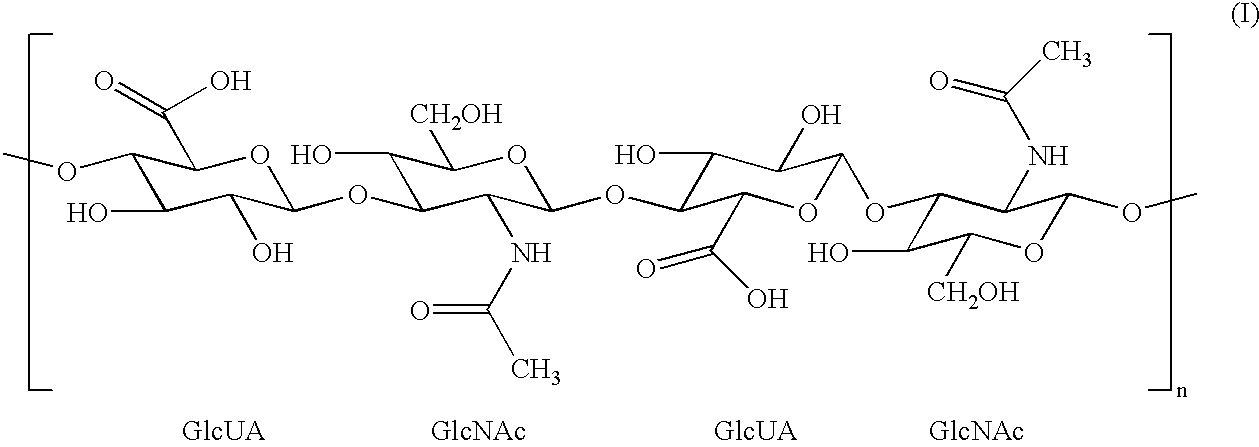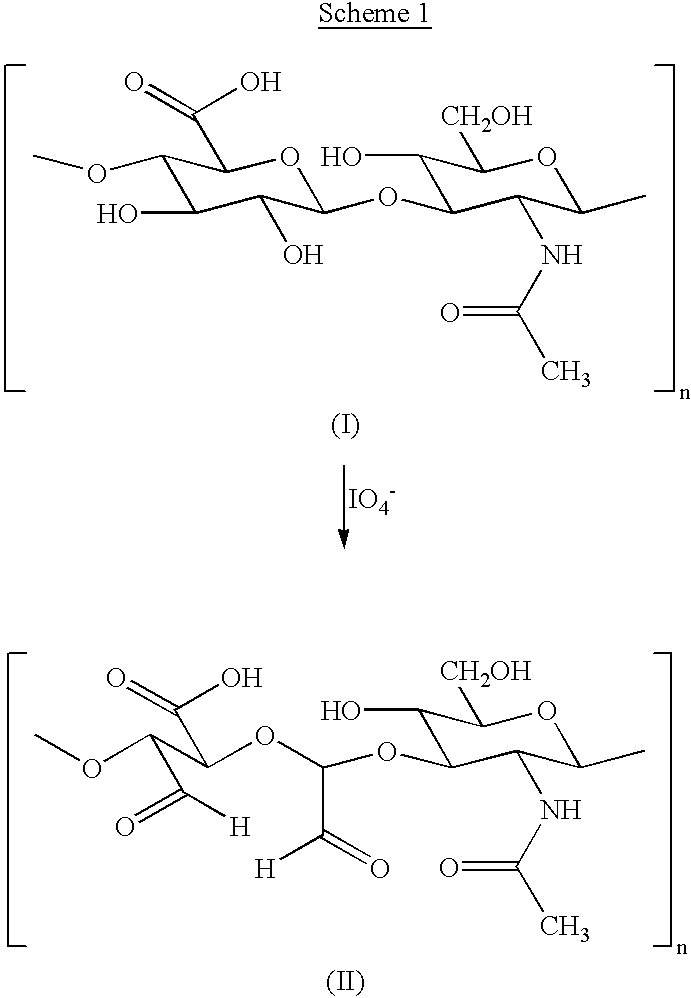Functionalized derivatives of hyaluronic acid, formation of hydrogels in situ using same, and methods for making and using same
- Summary
- Abstract
- Description
- Claims
- Application Information
AI Technical Summary
Benefits of technology
Problems solved by technology
Method used
Image
Examples
example 1
Preparation of N-(2,2-Dimethoxyethyl)-4-(methoxycarbonyl)butanamide (1)-EDC (4.98 g, 0.026 mol) was added to a mixture of aminoacetaldehyde dimethyl acetal (2.18 ml, 20 mmol) and methyl monoester of succinic acid (2.64 g, 20 mmol) in 75 ml of dichloromethane, and the reaction mixture stirred for 24 h at room temperature. The solution was extracted successively with 50 ml each of ice cold solutions of 0.75M sulfuric acid, 1M NaCl, saturated sodium bicarbonate, and 1M NaCl. The organic phase was collected and dried with sodium sulfate. The solvent was evaporated under reduced pressure yielding a syrup, which showed a single spot on charring upon TLC in solvent A (R.sub.f 0.75) and solvent B (R.sub.f 0.24). The apparent yield of 1 was 65%: .sup.1 H NMR in CDCl.sub.3 .delta. 5.70 (bs, 1H, NH), 4.34 [t, 1H, CH--(OCH.sub.3), 3.67 (s, 3H, COOCH.sub.3), 3.43-3.35 (s and t, 8H, CH.sub.3 OC and CHCH.sub.2 NH), 2.38-2.26 (m, 4H, CH.sub.2 CO).
example 2
Preparation of Aminoacetaldehyde-dimethyl acetal-HA (formula XX)-Sodium hyaluronate (100 mg, 0.25 mmol) and 2,2-dimethoxyethylamine (0.788 g, 7.5 mmol) was dissolved in H.sub.2 O (40 ml, 2.5 mg / ml HA). The pH was adjusted to 7.5 and NHS.SO.sub.3 Na (268 mg, 1.25 mmol) and EDC (240 mg, 1.25 mmol) was added and the reaction mixture was stirred overnight. The pH was subsequently adjusted to 7.0 with 1M NaOH and NaCl added to produce a 5% w / v solution. HA was precipitated by addition of three volume equivalents of ethanol. The precipitate was redissolved in H.sub.2 O at a concentration of approximately 5 mg / ml and the precipitation repeated twice. The purified product was freeze dried and kept at 4.degree. C. under N.sub.2. ##STR18##
example 3
Deprotection of HA-acetals to form HA-aldehydes--The acetal modified HA(formula XII) was dissolved in H.sub.2 O to a concentration of 5-10 mg / ml and 1M HCl was added to give a final concentration of 0.025M. The solution was then allowed to stand at room temperature for 0.5 to 1.0 h. The solution was neutralized by the addition of 1M NaOH, yielding the deprotected HA-aldehyde (formula XXII).
PUM
| Property | Measurement | Unit |
|---|---|---|
| Fraction | aaaaa | aaaaa |
| Mass | aaaaa | aaaaa |
| Mass | aaaaa | aaaaa |
Abstract
Description
Claims
Application Information
 Login to View More
Login to View More - R&D
- Intellectual Property
- Life Sciences
- Materials
- Tech Scout
- Unparalleled Data Quality
- Higher Quality Content
- 60% Fewer Hallucinations
Browse by: Latest US Patents, China's latest patents, Technical Efficacy Thesaurus, Application Domain, Technology Topic, Popular Technical Reports.
© 2025 PatSnap. All rights reserved.Legal|Privacy policy|Modern Slavery Act Transparency Statement|Sitemap|About US| Contact US: help@patsnap.com



